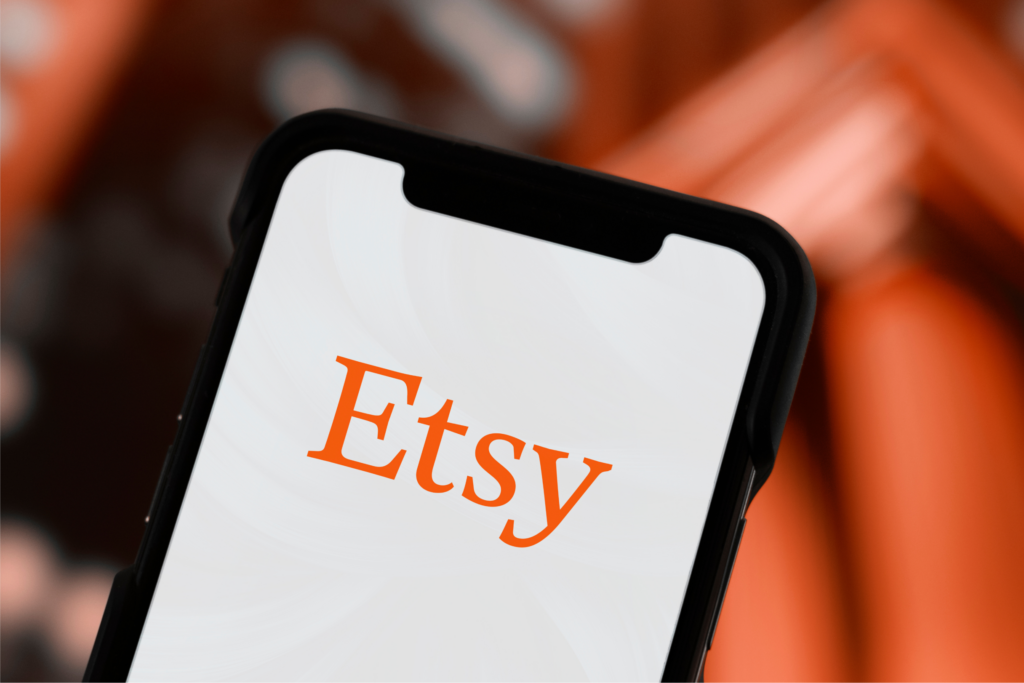Printify + your favorite platform = more sales!
Both Etsy and Amazon Handmade are leading eCommerce sales channels with massive customer bases. Let’s compare selling products on Amazon Handmade vs Etsy to determine the best marketplace for your online business.
Learn the differences in store setup, product listing, and customization, and discover insights on fees, market competition, and integrations.
Key takeaways
- Amazon Handmade has a more demanding application process and charges a 15% referral fee on every sale.
- Etsy accounts are easy to set up but charge various fees that can be challenging to navigate.
- Third-party solutions like Printify’s Print on Demand on Etsy are easy to add, which isn’t possible with Amazon Handmade.
- Amazon Handmade suits those who run an eCommerce business full time, while Etsy is ideal for part-time online store owners and entrepreneurs.
- Amazon Handmade and Etsy cater to different business needs, but both have a broad global audience.
Amazon Handmade
Amazon Handmade is a curated section of Amazon’s marketplace operating as a separate sales channel – designed for artisans selling handcrafted products.
It has millions of customers worldwide and provides unmatched exposure, but it has strict entry requirements and high fees.
Pros and Cons
As the largest online marketplace, Amazon Handmade offers excellent visibility and built-in customer trust.
Advantages:
- Large customer base – Millions of shoppers visit Amazon daily, increasing your reach.
- Extensive features – Benefit from Amazon’s fulfillment services and marketing tools.
- Strong customer support – Amazon handles disputes to maintain buyer confidence.
Disadvantages:
- Strict approval process – Not all artists and creatives qualify to sell on the platform, posing a challenge for smaller sellers.
- 15% referral fee – Higher commission fees cut into profit margins.
- Limited product categories – Only approved handmade goods can be listed.
Etsy
Etsy is a popular marketplace for hand-crafted goods, vintage finds, and creative supplies. It’s beginner-friendly, with a simple setup and niche audience actively searching for unique, handmade items.
Pros and Cons
Etsy is one of the easiest ways to sell online to a diverse community.
Advantages:
- Simple setup – No complex approvals, making it accessible for beginners.
- Low upfront costs – No monthly subscription fees, just listing costs to get started.
- Direct customer engagement – Build relationships and brand loyalty with buyers.
Disadvantages:
- Various expenses – Etsy charges listing, transaction, and payment processing fees.
- Slower customer support – Resolving seller issues can take time.
- Challenges for long-term selling – Sudden algorithm changes or policy updates may lead to unexpected suspensions.
Amazon Handmade vs Etsy
Both Amazon Handmade and Etsy cater to artisans selling handmade items, but they offer different experiences for sellers.
Here’s a quick comparison to help you decide which platform aligns best with your business.
| Feature | Amazon Handmade | Etsy |
|---|---|---|
| Approval process | Strict application, seller verification required | Open to all, no approval needed |
| Customer base | Millions of global Amazon shoppers | Niche audience looking for handmade goods |
| Selling fees | 15% referral fee on every sale | Multiple small fees (listing, transaction, processing) |
| Fulfillment | Option to use Fulfillment by Amazon (FBA) | Sellers handle fulfillment or use third-party services |
| Marketing and ads | Limited seller control, Amazon manages promotions | Broader control over advertising and SEO |
| Customer support | Amazon provides customer service for sellers and buyers | Seller-managed customer service with Etsy support |
| Customization | Restricted branding and personalization options | More control over shop branding and customization |
Product categories

Amazon Handmade is strictly for makers, while Etsy welcomes a wider variety of products like vintage goods and print-on-demand items.
Amazon Handmade
The platform exclusively carries handmade and unique items to maintain product authenticity. Sellers must undergo approval, follow strict listing policies and requirements, and only sell products in these top-selling categories:
- Artwork
- Baby supplies
- Beauty and personal care
- Apparel and accessories
- Outdoor and home products
- Jewelry and watches
- Kitchen and dining
- Pet supplies
- Sporting goods
- Stationery and party supplies
- Toys and games
Each category has curated subcategories, limiting what sellers can offer compared to Etsy.
Etsy
With a broader product range, sellers can list handmade and vintage (20+ years old) items as well as craft supplies.
Etsy also permits print-on-demand products through production partners, making it easier for you to scale with bestselling products. Categories include:
- Artwork and prints
- Handmade jewelry
- Clothing and accessories
- Personalized products
- Vintage items
- Crafted goods
- Craft supplies and tools
- Phone cases
- Stationery and party supplies
- Pet supplies
- Digital prints
- Toys and games
Subscription costs and fees
While neither platform requires an upfront payment to start selling, they have different pricing structures.
Amazon Handmade has no recurring listing fees, reducing small payments that can add up even before making sales, but its higher commission fee impacts profitability.
Etsy sellers pay more frequent small fees, but overall costs may be lower if you have a small sales volume.
Amazon Handmade
Amazon has two seller subscription options – Individual and Professional – but you need the costlier Professional plan to apply to Amazon Handmade.
But there’s an upside – Amazon Handmade waives the $39.99/month Professional selling plan fee after the first month of approval, making it free to join as long as you’re accepted on the first attempt.
However, sellers must pay a 15% referral fee per sale, which can cut into profit margins.
Etsy
Etsy has a free Standard plan and a $10/month Etsy Plus plan, which includes customization tools and discounted shipping labels. However, Etsy sellers face multiple mandatory fees:
- Recurring listing fees: $0.20 per listing (four-month active period before renewal)
- Transaction fee: 6.5% per sale
- Payment processing fee: 3% + $0.25 (US)
You also need to consider business or region-specific fees, optional advertising fees, and branding costs that can add up. This might make Amazon Handmade cheaper depending on your business strategy and sales volume.
Use our Etsy calculator to simplify your pricing strategy and easily measure profitability.
Competition and marketplace visibility
Amazon Handmade reaches a broader market, while Etsy’s niche audience means tougher competition – requiring you to invest more in branding and product promotion to stand out.
Amazon Handmade
Selling on Amazon Handmade means competing with both handmade and mass-produced products on Amazon’s marketplace.
But their global customer base gives higher exposure for sellers who know how to optimize listings and use Amazon’s built-in marketing.
Etsy
Etsy’s niche-focused audience actively searches for handmade and unique items.
However, high competition among independent sellers means you must optimize for SEO, reviews, and Etsy Ads to gain visibility. While there’s a high intent to buy, standing out can be challenging.
Integrations
Amazon’s powerful fulfillment network streamlines order processing, while Etsy supports marketing, inventory, and print-on-demand integrations.
Amazon Handmade
Amazon Handmade compared to Etsy offers less flexibility due to limited third-party integrations. However, their sellers can benefit from FBA to store, pack, and ship products.
You must also list products and manage your store through Amazon Seller Central, which has a steeper learning curve than Etsy’s dashboard.
Etsy
Etsy integrates with various third-party tools, including:
- Product and order fulfillment services
- Inventory and order management systems
- Social media and email marketing integrations
- Marketing and order automation tools
The Etsy Seller Dashboard simplifies management, letting you sync orders, update products, track sales, improve Etsy SEO, and enable Etsy Ads easily.
Store setup

Setting up a store on Amazon Handmade requires approval, while signing up for Etsy is easier and lets you start listing products quickly.
Amazon Handmade
There’s a strict application process, which includes verifying that all products are genuinely handmade. Approval can take weeks or months, making it less accessible for new sellers, but it does offer good protections and resources after setup.
Once approved, you’ll receive a Maker Profile for account customization through Amazon Seller Central. The Professional plan offers enhanced product pages, a digital store, and useful branding tools.
Etsy
Etsy’s store setup is fast and beginner-friendly. Register, specify your Etsy shop’s preferences, and start listing products immediately.
The seller dashboard has everything to manage listings, track orders, optimize stores, and enable customization options:
- A store banner and logo
- A personalized About section
- Shop policies and FAQs
Check out our guide on how to start selling with Etsy.
Customer support
Amazon Handmade offers 24/7 customer support and handles buyer disputes while providing robust seller protections. Etsy’s support is slower but gives you direct communication with customers.
Amazon Handmade
The marketplace provides dedicated customer service, but sellers don’t have direct communication with buyers.
While this helps reduce your workload and protect you as a seller, it also limits opportunities for personal engagement, making it harder to build customer relationships.
Etsy
There’s an Etsy FAQ section, community forums, and email support. However, response times can be slow.
Sellers manage customer service directly, which can be both an advantage and a challenge. This can lead to higher customer loyalty, but resolving disputes requires careful handling.
Amazon Handmade vs Etsy: Which is the better marketplace?

Amazon Handmade sellers gain access to a global customer base but must navigate a strict approval process and higher fees.
In contrast, the Etsy platform is more accessible with customization and direct customer engagement, but has recurring fees and tougher niche competition.
Here are key factors to help determine which online marketplace is the better fit for your business:
- Registration and store setup: Amazon Handmade has an extensive approval process, while Etsy allows instant store creation.
- Subscription costs and fees: Amazon Handmade has no listing fees but charges a 15% referral fee, while Etsy has recurring listing fees and transaction costs.
- Marketplace density and competition: Both have a global customer base. Etsy has a competitive seller demographic that attracts a niche audience, while Amazon Handmade has a broader overall reach.
- Integrations and selling tools: Etsy offers third-party integrations like Printify and Squarespace, while Amazon Handmade operates within the Amazon ecosystem.
- Customer support and seller interaction: Amazon Handmade provides 24/7 customer support but limits direct buyer-seller communication. Etsy requires sellers to handle support directly and may offer slower assistance.
Amazon Handmade: Best for high-volume sellers looking for efficiency
Is Amazon Handmade better than Etsy? For artisans aiming to reach a massive customer base with minimal direct customer interaction, it may be the better option.
Since only verified handmade sellers can list products, the platform offers credibility and consumer trust. However, the lack of direct buyer-seller communication may make it harder to build customer relationships.
In terms of Amazon Handmade fees vs Etsy, the absence of other overheads beyond the 15% referral makes it a strong choice for higher-value items or sellers with a big sales volume.
Amazon’s FBA means streamlined logistics, reducing the need for hands-on order management. Plus, Amazon pays sellers through a structured payout system.
Etsy: Best for independent sellers focused on branding and customer engagement
Is Etsy better than Amazon Handmade? The Etsy marketplace is ideal for small businesses and independent artisans who prioritize brand identity and customer interaction.
Whether selling vintage goods, custom crafts, or digital downloads, an Etsy shop supports greater personalization and flexible product listings.
Although Etsy fees can add up, many find the platform’s brand-building potential worth the investment. Etsy’s third-party integrations also let you start selling with Print on Demand, easing fulfillment.
Plus, Etsy fosters seller-buyer relationships through storefront customization and direct communication – a key advantage for those who rely on repeat customers and word-of-mouth marketing.
Sell handmade items using Print on Demand with Printify!
Start a thriving eCommerce business on the sales channel of your choice today.
FAQ: Amazon Handmade vs Etsy
If you plan to sell custom print-on-demand products, go with Etsy. While you can sell Print on Demand on Amazon, Handmade targets artisans offering hand-crafted items.
Check out the full list of Printify integrations to see what works best for your business.
It can be challenging to sell on Amazon Handmade due to its rigorous application process and competition with broader marketplace sellers.
Applicants must undergo a detailed review to comply with Amazon Handmade policies, and acceptance isn’t always guaranteed.
You must have a Professional seller account, costing $39.99/month. However, if you apply and are approved to sell on Amazon Handmade, the platform will waive this fee after the first month. Amazon also charges a 15% referral on every order.
While Amazon doesn’t release specific data on Amazon Handmade’s customer base, the platform benefits from its association with the larger marketplace, attracting millions of shoppers worldwide.
Yes, Amazon Handmade can be profitable for sellers with high-margin, quality products. Just note the 15% referral fee when crafting your pricing strategy.
The cost of selling on Etsy vs Amazon Handmade varies. Etsy fees include recurring listing fees and a 6.5% transaction fee. Amazon Handmade has no listing fees but charges a higher 15% referral fee per sale.
Amazon Handmade is one of Etsy’s main competitors, offering a dedicated marketplace for artisans. However, other platforms like eBay and Shopify also compete with handmade and vintage items.
Amazon Handmade takes 15% per sale, which includes payment processing. Unlike Etsy, there are no recurring listing fees, but sellers must open a Professional account for $39.99/month, which Amazon waives after approval.
To wrap up
When you compare selling on Amazon Handmade vs Etsy, both marketplaces offer competitive pricing and a large customer base.
But is it better to sell on Etsy or Amazon? Targeting Etsy shoppers is great for entrepreneurs and part-time online store owners, while Amazon Handmade is better for growing a full-time business.
Want to expand your lineup beyond handmade products? Partner with Printify for free to fill your virtual shelves with custom merch.












